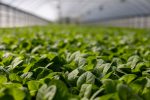Late blight – Phytophthora infestans
Late blight background Late blight (Phytophthora infestans) is very destructive under conditions of excessive moisture and low temperatures. Starts as small water soaked lesions which rapidly enlarge with a brown or black colour. Spreads rapidly and total plantings can be destroyed within a week. Late blight symptoms
The disease causes severe defoliation of tomatoes and a destructive rot of the fruit. The first signs are irregular, greenish black water soaked patches appear on the older leaves. These spots enlarge rapidly and in moist weather a white downy growth of the fungus develops. The stems may also have water-soaked, brown areas similar to those on the leaves. In warm weather the disease spreads so rapidly that almost all foliage is affected and the plants look as if they have been damaged by frost. Fruit are infected at any stage of growth. It is most common on the upper half of the fruit, but may occur elsewhere on the surface. The first signs of late blight can be confused with buck eye rot. The spot is slightly sunken and a white fungus can be found on the fruit. In moist weather conditions the fungus produces abundant spores on the underside of the leaves. Spores are easily transferred to other plants through wind, handling of plants etc. Ideal temperatures for the fungus to develop is between 5°C and 21°C. However the fungus quickly dies between 24°C and 27°C. The fungus needs moisture to survive and if average temperatures are above 24°C it will be kept in check. The fungus does not seem to survive on dead plant material, however, it does survive on potato tubers left in the soil. Late blight control
- Due to the fact that the fungus needs specific environmental conditions to infect, fungicide application should only start when the first signs of infection are visible.
- All registered fungicides have a systemic action and may not be applied more than four times a season, otherwise resistance may be encountered.
- Remove all volunteer potato plants which might serve as a source of infection.



